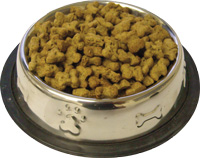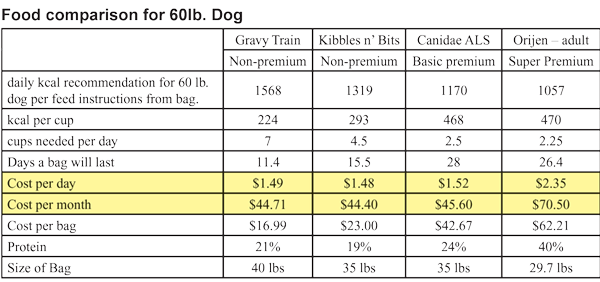 The most often reason we hear people say they don’t feed their dogs a premium dog food is because the bag is so expensive! But is it really? Here’s a comparison: The most often reason we hear people say they don’t feed their dogs a premium dog food is because the bag is so expensive! But is it really? Here’s a comparison:
$50 bag vs. $25 bag (hint they cost the same!!) – HOW?
A 30 pound bag of value brands like Pedigree, Purina or Gravy Train will cost around $25 and recommend to feed a 50lb. dog 5 cups of food. A 30 lb. bag of premium foods like Canidae, Taste of the Wild or NutriSource cost around $50 and say to feed a 50 lb. dog 2 1/2 cups of food a day.

What? Well it means that most premium brands recommend you to feed a much smaller amount of food to your dog, sometimes up to half of what a value brand recommends. So your dog has to digest much less fillers and that means less gas and smaller poops! Plus there are very few preservatives and artificial flavors in premium foods. They use higher quality meats and grains which naturally drives pets to eat them.
Here is a comparison of 4 foods and what they really cost you per day and per month rather than per bag:
We have even found that brands like Iams, and Eukanuba have smaller feed ratios than value brands, but can cost only 10-20% less than a premium brand and often cheap grains are listed first or multiple times in the top 6 ingredients which means its full of cheap filler and your paying a much higher price.
Also foods that are high in grain also require a higher kcal ratio because the calories are not a natural source of energy and therefore your dog or cat has to eat more of it to get the same amount of nutrition as a food that is high in fat and protein. These calories are basic sugars and not useful to dogs the way protein and fat are, so their digestive systems are using this basic sugar as fuel and even small traces of calories they are not burning through exercise are being stored as fat! So if there is any surplus of calories it contributes to weight gain. That means the more grain in a food the more likely even slightly overfeeding will have compounding weight gaining effects. Often “weight management” food will substitute grains for fat and proteins to reduce the fat amount and make your dog feel full. The calories they are consuming are loaded with non nutritious filler to feel full, so often they will want to eat more of the weight management food. Low fat dog foods do not help your dog lose weight, calorie restriction and exercise is the most effective way.
So how can you tell if a brand is good or not? Here is a list of ingredients to look for and more importantly ingredients TO AVOID!
Ingredients to LOOK FOR when purchasing dog food and the reasons why they are important…
• Specifically named meat protein sources, such as chicken, turkey, lamb, beef, etc. There is a debate over whether whole meat, such as ‘chicken,’ is better than meal, and vice versa. The difference is that meal has had all the moisture removed before being processed into kibble and whole meat is left intact. This means that a pound of ‘chicken meal,’ for example, is made of more meat than a pound of ‘chicken,’ because up to 70% of the weight of the ‘chicken’ can be water weight. The worst protein source for pet food is “Meat Meal” this is the bad stuff (anything from road kill, zoo animals too large to cremate or euthanized pets). Yes if your pet is eating a food with meat meal they are more than likely eating euthanized pets!
• Good carbohydrates, such as brown rice, oatmeal, millet, amaranth, and potatoes (not potato product) or sweet potatoes. These are considered good carbohydrates, because they do not have un-wanted side effects. However, carbohydrates are really not needed by the dog, because dogs get more of their energy from meat protein & fat. These fillers are less likely to cause allergic reactions than cheap fillers.
• Specifically named fat sources, preferably animal fats such as ‘chicken fat.’ Dogs are able to utilize animal fats better than vegetable oils, but sunflower and flaxseed oils (as long as your dog is not sensitive to them) are okay, too. Try to avoid foods that contain beef tallow, generic vegetable oil, poultry fat and mineral oil.
Ingredients to AVOID when purchasing dog food and the reasons why…
• By-products are what are left over after the processing plants remove what meat is fit for human consumption.
By-products can contain anything from chicken heads and feet, to cow hooves and horns, fur, feathers, blood, skin, bone, feces, and even dirt and sawdust from the floors of the meat processing plant. These are not nutritious forms of calories, and all the pet food companies that use these as protein sources have to supplement vitamin and minerals to ensure your dog is not malnourished.
• Corn in any form (ground yellow corn, corn meal and corn gluten meal) is what is known as filler (soy and sorghum fall under this category as well) and it serves one primary purpose in dog food – to make the animal feel full. Dogs cannot digest corn and utilize the protein it contains, so it basically just passes right through the digestive system and you get the privilege of cleaning it up when it comes out the other end. Some dogs are also allergic to corn, so if you simply avoid any foods that contain any form of corn in their ingredients listing you’ll be doing your dog and yourself a big favor.
• Wheat is really only an issue if your dog is allergic to it, but wheat also played a big part in the recent pet food recalls, so avoiding it altogether is a good idea.
• Chemical preservatives such as BHA, BHT and propylene glycol make the food last longer than natural preservatives, but every single one of them has been proven to cause liver and kidney failure, cancer, or other
life-threatening diseases in test animals.
|